Broker Complaints Report for 2025
We took 10 of the largest brokers, and analyzed approximately 1,000 one- and two-star reviews over 12 months across the App Store, Google Play, review sites like Trustpilot, and Google, to see where the biggest brokerages are falling down.
This report digs into what disgruntled customers have been saying about the biggest brokerages. By documenting and analyzing their complaints, we reveal recurring pain points, highlight issues eroding user trust, and find out where firms can improve.
Key Takeaways
Why user reviews matter:
- Reviews often reflect real user experiences, revealing how brokers actually perform, not just what they promise.
- 90% of US consumers feel reviews in the financial sector are either ‘important’ or ‘very important’ in their decision-making.
Expectations are shifting:
- Commission-free trading and advancements in technology have led traders to seek speed, accessibility, and a seamless user experience.
- In an era of instant feedback, traders also expect transparency, quick resolution, and trustworthy service, and they can be quick to switch brokers after a poor experience.
Scope:
- We evaluated one- and two-star reviews for major brokers over 12 months (September 2024 to September 2025).
- We read and recorded 946 reviews, removed 35 due to various concerns, and sorted the remaining 911 into 15 categories. Overlaps indicate reviews that raised multiple issues.
- We focused on 10 brokers: Trading 212, Robinhood, Fidelity, Charles Schwab, Vanguard, Capital.com, E*Trade, ThinkMarkets, Markets.com, Admiral Markets.
Headlines:
- Poor app experiences were the most common complaints across all categories and crossovers with 386 (42.4%).
- Customer support issues showed up in 194 (21.3%), often paired with other problems.
- Concerns about trading conditions like execution issues received 190 (20.9%).
- Complaints about payments and account transfers showed up in 152 (16.7%).
- Large, traditional brokers (e.g., Fidelity, Schwab, Vanguard) often received the most criticism for outdated designs and slow support.
- Newer, mobile-focused brokers (e.g., Trading 212, Capital.com) earned higher praise for their responsiveness despite their smaller market share.
- The table below breaks down the number of individual issues and crossovers separately.
| Complaint Categories & Crossovers | Count |
|---|---|
| App Experience | 358 |
| Trading Conditions | 161 |
| Payments or Transfers | 110 |
| Customer Support | 103 |
| Account | 65 |
| Customer Support & Payments or Transfers | 30 |
| Customer Support & Account | 24 |
| Customer Support & Trading Conditions | 15 |
| Customer Support & App Experience | 13 |
| Customer Support & Registration | 9 |
| App Experience & Trading Conditions | 8 |
| Account & Payments or Transfers | 4 |
| App Experience & Payments or Transfers | 4 |
| Trading Conditions & Payments or Transfers | 4 |
| App Experience & Registration | 3 |
What we learned:
- Delayed or absent responses during critical events (e.g., frozen accounts, fund delays) can severely damage trust.
- Real-time, human help prevents problems escalating, but many brokers increasingly lean on chatbots that are frustrating to deal with in a crisis.
- Prompt deposits and withdrawals are a must to prevent major frustrations.
- Fast, reliable apps can beat out the biggest brands and count for more than low fees.
Our Methodology
We collected around 100 one-star and two-star reviews per brand over a 12-month period across the App Store, Google Play, Trustpilot, and Google Reviews.
We looked at 10 of the largest, well-known brokerages:
- Trading 212
- Robinhood
- Fidelity
- Charles Schwab
- Vanguard
- Capital.com
- E*Trade
- ThinkMarkets
- Markets.com
- Admiral Markets
Complaints were then categorized by theme (sometimes more than one theme per review) to identify the issues that crop up the most.
Here’s a breakdown of each key theme:
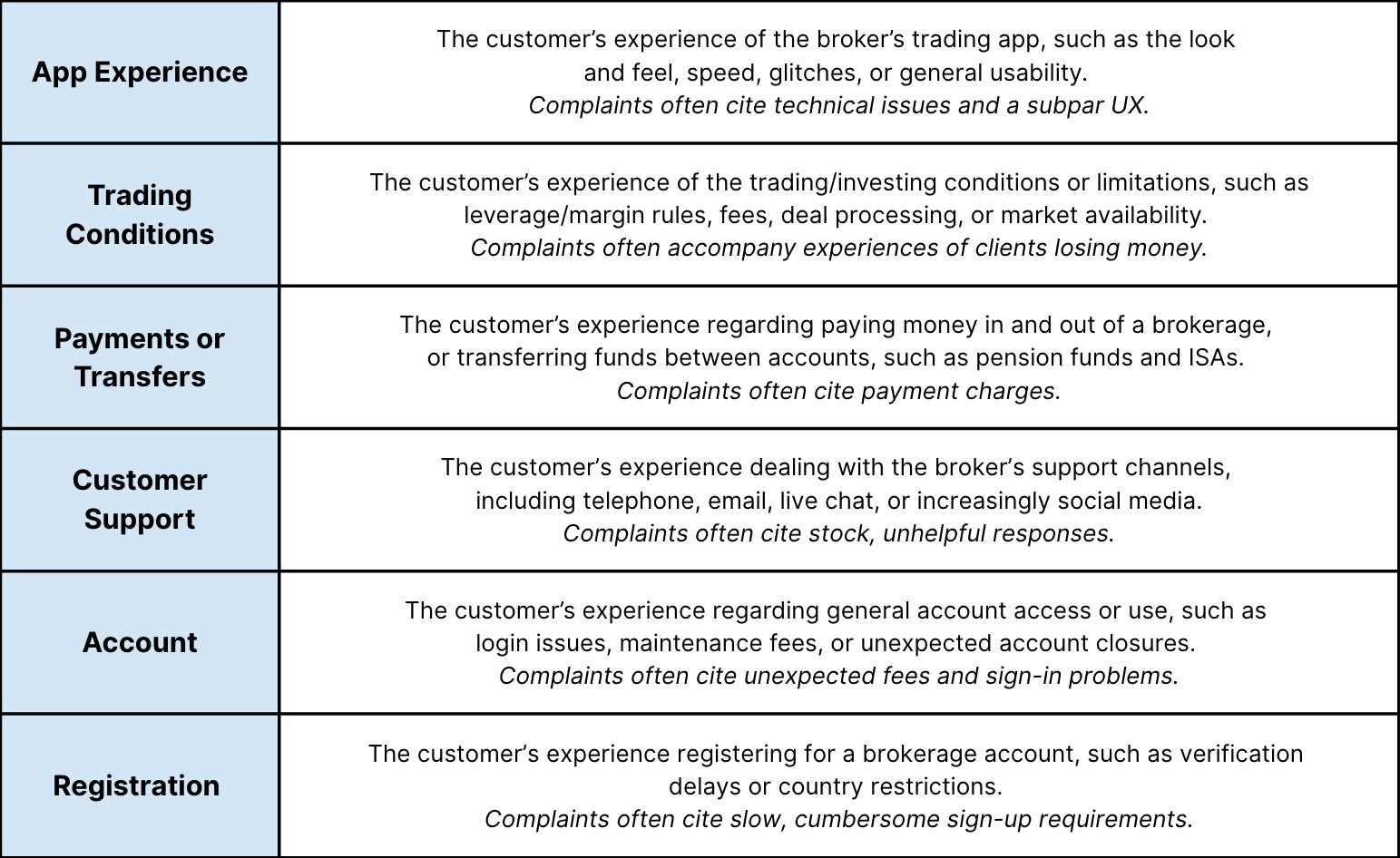
Complaint Category Rankings
The chart below summarizes complaint categories and their frequency. It also shows the number of crossovers – where multiple issues were flagged in the same review.
Key Themes and Pain Points
1. App Experience – The Leading Source of Complaints
The most significant dissatisfaction – over 358 complaints – concerned app usability, design, and reliability.
Customers frequently described apps from major investment firms (notably Fidelity, Charles Schwab, and Vanguard) as outdated, unintuitive, and lacking essential features.
Several users also announced their intentions to turn to more modern apps such as Trading 212 and Robinhood.
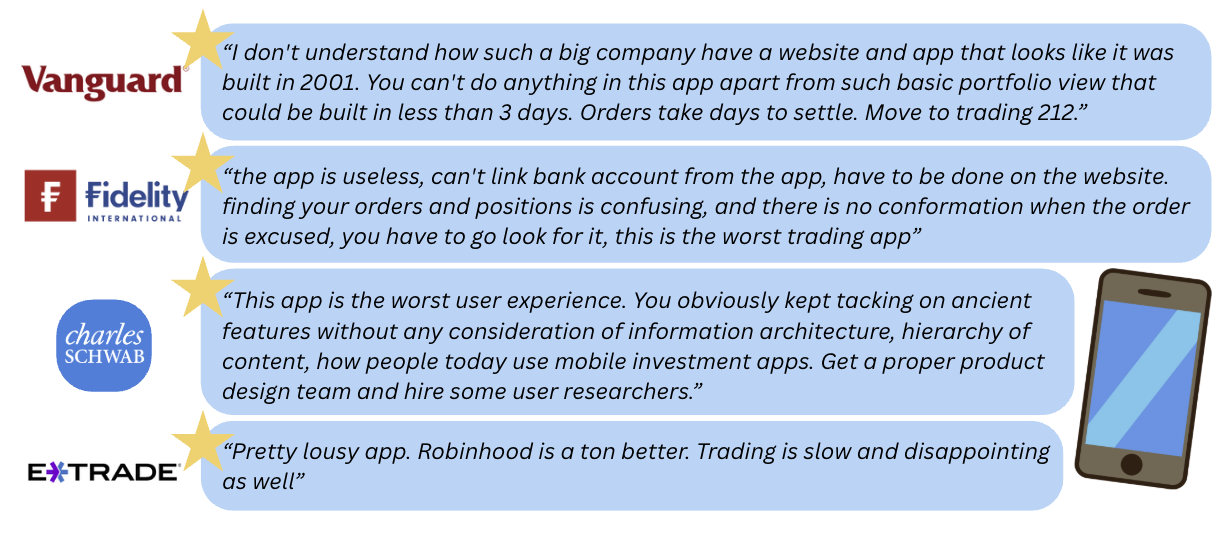
2. Trading Conditions and Payment Frustrations
With 161 complaints tied to trading conditions, and 110 complaints regarding deposits, withdrawals, and account transfers, many customers expressed frustration over standard daily processes at their broker.
Funding fees, suboptimal execution, slow settlement times, and withdrawal delays were particular pain points for many customers. Some users highlighted serious concerns with missed market opportunities and lost money due to processing inefficiencies.
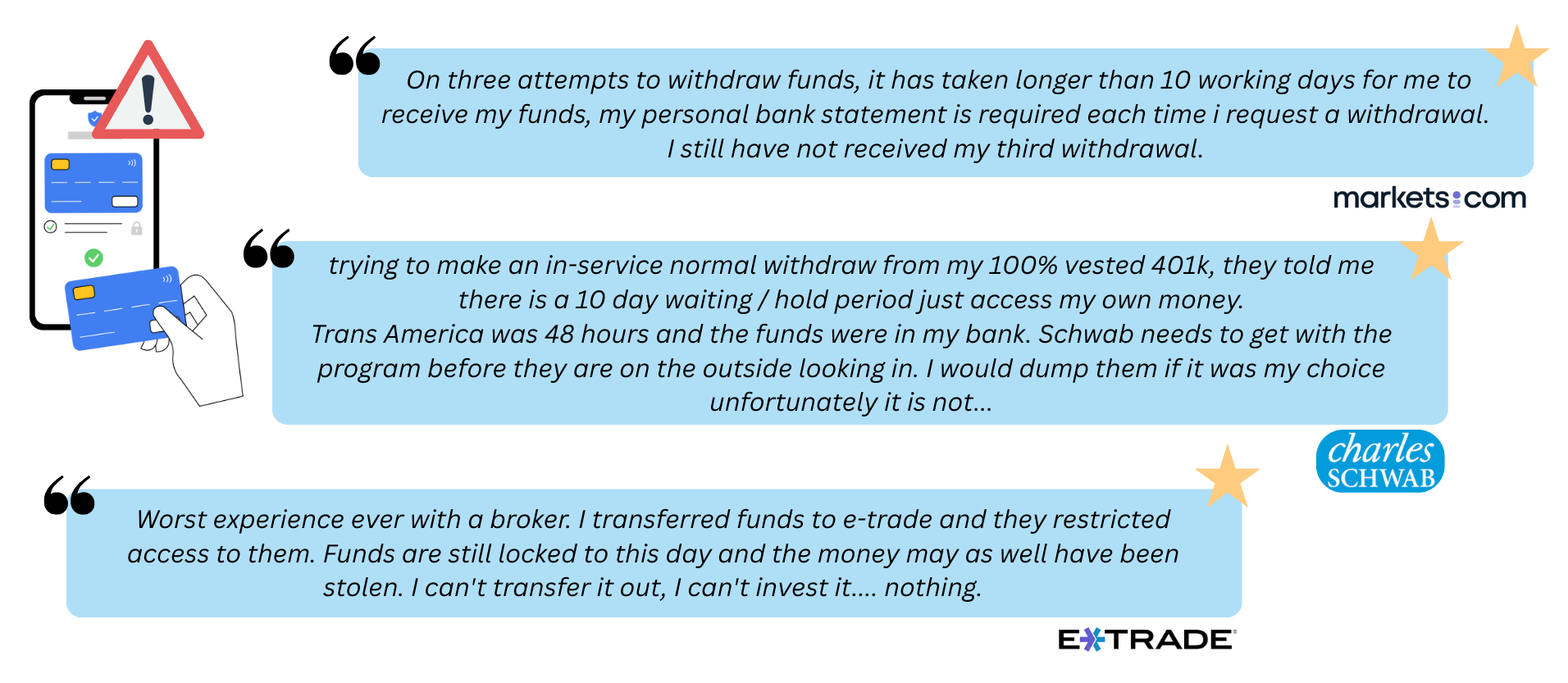
That said, of the user reviews we evaluated, Trading 212, Capital.com and Admiral Markets impressed us with how they responded to complaints promptly, addressing each customer’s individual concerns.
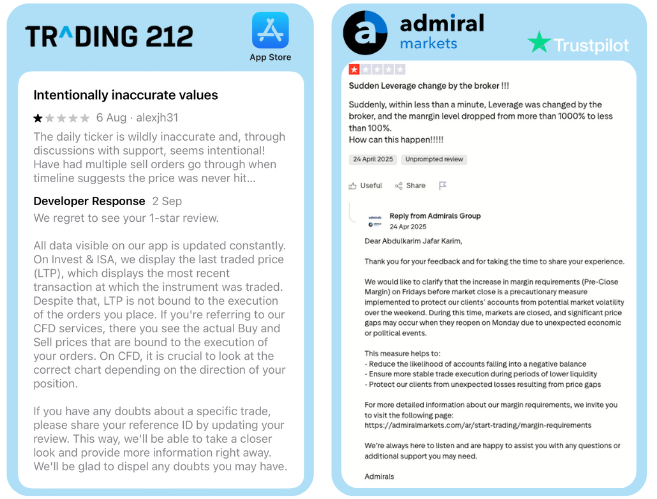
On the other hand, the other brokerages in our evaluations either replied with generic and unhelpful responses or failed to respond to many negative reviews at all.
3. Customer Support Failures
Poor customer service ranked as a major driver of dissatisfaction (103 direct mentions, with overlaps across six categories, notably payments, account issues and general trading conditions).
The pie chart below shows the level of overlap in support issues.
Complaints emphasized slow response times, unhelpful agents, and a lack of accessible support channels, especially at major brokerages like Fidelity, Charles Schwab and Vanguard.
For those using active trading platforms such as Robinhood, some customers cited a complete lack of any customer support altogether during critical events such as account closures and withdrawal delays.
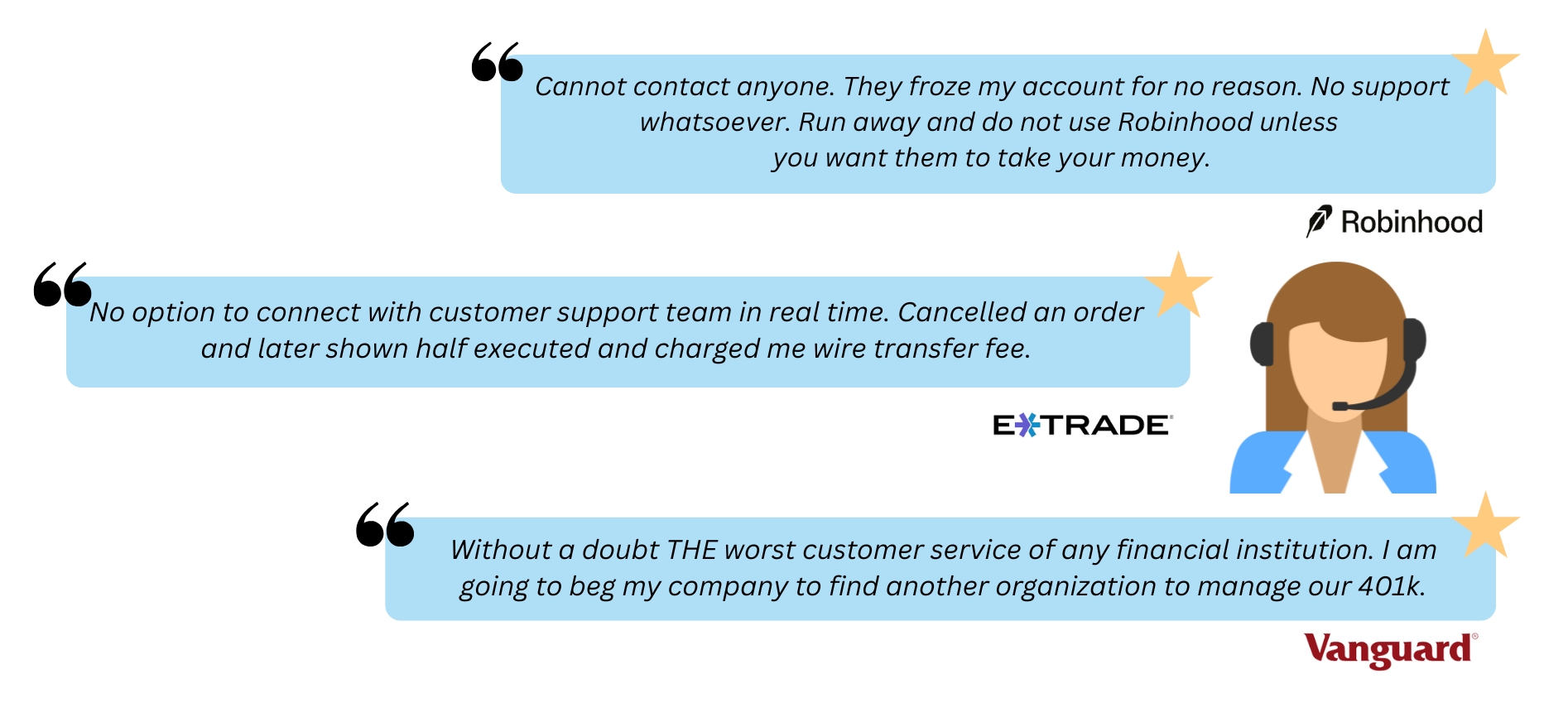
What Should Brokers Take From This Report?
The message from traders is clear: investment apps and trading platforms are sometimes falling behind user expectations. Our findings show that today’s investors are no longer just judging brokers by traditional metrics like brand heritage or product range.
Customers consistently pointed to the same frustrations – clunky mobile apps, poor communication, and delays that can affect trading outcomes.
- Invest in Modern, User-Centered Apps: In an era where more traders are managing portfolios entirely from their phones and tablets, brokers must treat app design as a priority, not a secondary channel. Regular UX testing, simplified navigation, and faster load times are now key to retaining digitally savvy investors.
- Improve Customer Support Responsiveness: Poor support doesn’t just frustrate users – it can amplify other issues. Brokers should prioritize 24-hour response capabilities for active traders where possible, live chat options, and proactive communication during technical or transactional disruptions.
- Streamline Transactions and Withdrawals: Speed and transparency are non-negotiable. Brokers can regain confidence by setting clear expectations on transfer times, providing real-time status updates, and automating common payment processes to reduce friction.
- Be Transparent About Fees and Account Issues: Traders want to understand what they’re being charged and why certain restrictions apply. Clearer fee disclosures, consistent communication, and smoother verification steps can go a long way toward building trust.
- Bridge the Trust Gap Through Communication: Silence breeds distrust. Publishing system updates, acknowledging outages, and responding openly to negative reviews can help humanize a brand and reassure users that their concerns are being heard.
What Should Traders Take From This Report?
Our research shows that not all brokers deliver the same experience. While marketing materials may emphasize low fees and investment choice, the real test often lies in how well a platform performs when users actually trade, withdraw funds, or seek help.
For traders, especially those engaging in frequent transactions, this means taking a more investigative approach before choosing a broker:
- Prioritize user experience and reliability: Before signing up, explore app demos, read recent user feedback, and pay attention to recurring complaints about order execution, app crashes, or delayed updates.
- Assess customer support responsiveness: A fast, accessible support team is not just a convenience – it’s a safety net when real money is at stake. Look for brokers that offer live chat and transparent resolution processes. A human agent should be easy to get through to.
- Evaluate transaction efficiency and transparency: Complaints around slow withdrawals and unclear fees highlight the need to review terms carefully. Ensure the broker provides clear timelines for transfers, accessible account statements, and upfront fee disclosures.
- Look beyond reputation and size: Some of the larger, best-known brokers we evaluated were also among the most criticized for their outdated app design and functionality. Don’t assume size equals superior service – smaller, tech-forward brokers may offer more intuitive tools and faster response times.
- Use reviews as a strategic resource: Treat customer feedback as valuable insights. Trends in recent reviews can expose systemic problems. Checking multiple sources (app stores, dedicated review sites, user forums) can give a fuller picture of performance and reliability.
Reviews Shouldn’t Be Taken As Gospel
Individual user reviews are valuable, but they also warrant some scepticism. Each review is personal feedback that depends on the customer’s own experience and/or knowledge of the financial markets.
If a trader or investor is a beginner, we’ve seen that this can sometimes lead to a poor experience if a concept is misunderstood or if the trading conditions and requirements are not thoroughly researched before trading.
And in general, users are often more likely to post a review when they’ve had an especially negative (or positive) experience, so user reviews can paint an extreme picture, with the reality that the experience for most traders is somewhere in the middle.
Neutrality & Disclosures
- No Targeting: Our goal was to inform – not to target, criticise, or disparage any firm. Findings summarize user-reported experiences and thematic patterns in publicly available reviews. We reference specific brands or quotes only when necessary to illustrate a theme.
- Right of Reply & Corrections: If a broker believes any description is inaccurate or incomplete, please contact us at outreach@brokerlistings.com. We’ll review substantiated feedback and publish any corrections, clarifications, or a company statement where appropriate.
- No Rankings or Endorsements: Appearance or order of brands does not constitute a ranking, rating, or endorsement. Inclusion is based on data availability within the review sources, brands selected, and timeframe sampled.
- Exclusions: 35 reviews we discarded from the analysis on account of errors, bias, or other problems.
- Quotes & Attribution: Quoted reviews are verbatim excerpts from public platforms and reflect the authors’ opinions. Where we paraphrase for brevity, we aim to preserve meaning and context and can provide full citations on request.
- Trademarks: All trademarks, logos, and brand names are the property of their respective owners and are used here for identification purposes only.
- Compensation & Conflicts: In planning and performing this study, BrokerListings.com received no compensation from the brokers referenced, nor any brokers not referenced.
- Data & Privacy: We analyzed publicly available reviews and did not process personal data beyond what is already public. Any incidental personal information in quoted reviews has been minimized or redacted where practical.
- Methodology Notes: Percentages are based on issue mentions (not unique reviews) – a single review can include multiple issues.
- Time-Bound Snapshot: The analysis covers a defined 12-month period and may not reflect subsequent product updates, policy changes, or remediation actions by brokers.
- Use at Your Own Risk: Information is provided “as is,” without warranties of accuracy or completeness. Use this report as one input to your own assessment.
- Not Investment Advice: This report is for general information only and does not constitute investment, legal, tax, or other advice.
Article Sources
How Much Do Online Reviews Matter to Banking Decisions? A Whole Lot. – The Financial Brand